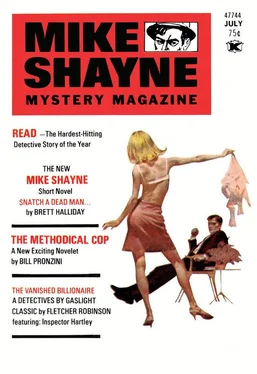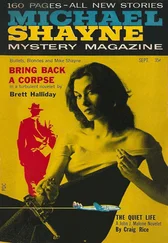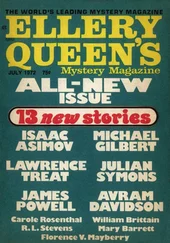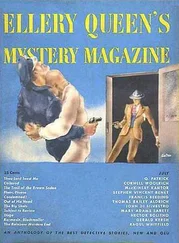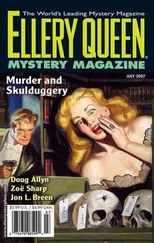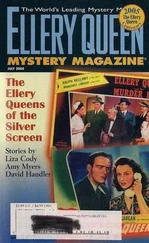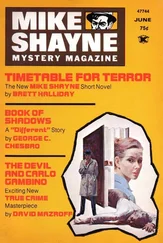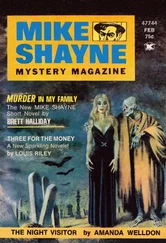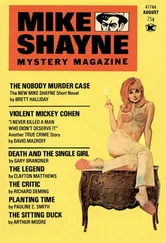Бретт Холлидей - Mike Shayne Mystery Magazine, Vol. 33, No. 2, July 1973
Здесь есть возможность читать онлайн «Бретт Холлидей - Mike Shayne Mystery Magazine, Vol. 33, No. 2, July 1973» весь текст электронной книги совершенно бесплатно (целиком полную версию без сокращений). В некоторых случаях можно слушать аудио, скачать через торрент в формате fb2 и присутствует краткое содержание. Город: Los Angeles, Год выпуска: 1973, Издательство: Renown Publications, Жанр: Детектив, на английском языке. Описание произведения, (предисловие) а так же отзывы посетителей доступны на портале библиотеки ЛибКат.
- Название:Mike Shayne Mystery Magazine, Vol. 33, No. 2, July 1973
- Автор:
- Издательство:Renown Publications
- Жанр:
- Год:1973
- Город:Los Angeles
- ISBN:нет данных
- Рейтинг книги:4 / 5. Голосов: 1
-
Избранное:Добавить в избранное
- Отзывы:
-
Ваша оценка:
- 80
- 1
- 2
- 3
- 4
- 5
Mike Shayne Mystery Magazine, Vol. 33, No. 2, July 1973: краткое содержание, описание и аннотация
Предлагаем к чтению аннотацию, описание, краткое содержание или предисловие (зависит от того, что написал сам автор книги «Mike Shayne Mystery Magazine, Vol. 33, No. 2, July 1973»). Если вы не нашли необходимую информацию о книге — напишите в комментариях, мы постараемся отыскать её.
Mike Shayne Mystery Magazine, Vol. 33, No. 2, July 1973 — читать онлайн бесплатно полную книгу (весь текст) целиком
Ниже представлен текст книги, разбитый по страницам. Система сохранения места последней прочитанной страницы, позволяет с удобством читать онлайн бесплатно книгу «Mike Shayne Mystery Magazine, Vol. 33, No. 2, July 1973», без необходимости каждый раз заново искать на чём Вы остановились. Поставьте закладку, и сможете в любой момент перейти на страницу, на которой закончили чтение.
Интервал:
Закладка:
“I seem to be following you straight to hell, counselor.”
“It’s not going to be as bad as that, I assure you. Let’s begin with the vigorish, Sol. What’s the vig on a Ventura loan?”
“It varies. Small loans come high and very short term. Big ones not quite so high, with longer terms.”
“Let’s focus on Kessell Construction.”
“Five per cent.”
“Weekly?”
“What else? Ventura is not your friendly banker.”
Woolstock looked across at Esmond. “In case you’ve never stopped to figure this out, Jim, and in order that Marie may take it down for the record, the Kessells borrow a hundred thousand dollars from Public Opportunities Corporation, an alleged real-estate appraisal outfit, whose executive officer is One-eye Pace, a muscle man pure and simple, who wouldn’t know a title deed from a cornerstone. He’s just a front for Ventura. But on the face of all public records, Ventura has no connection with Public Opportunities. He’s in another business altogether, namely wholesale produce, which he is operating legitimately by the way but at a margin of profit that is microscopic.
“Ventura’s legitimate company is heavily mortgaged to the Shippers Bank and Trust Company, which holds a legal charter from the State Banking Commission and whose president is one Harvey L. Davenport.
“Now who is Harvey L. Davenport? He’s a well-educated business man who happens to be married to Guido Scarpino’s oldest daughter. Which means Davenport is a front for Scarpino, even as Ventura is an apparent front for Davenport. But you can be sure that Scarpino is not on the board of directors of Shippers Bank. Still he is well enough represented to control it. I won’t go into the complex relationships right now.
“Let me get back to the Kessell loan.”
“First, John,” Esmond said, “fill me in on how the Kessells found Public Opportunities — one hell of a sardonic name, isn’t it? — or how Public Opportunities found the Kessells.”
“All right.” Woolstock winked kindly at Sol Steinbach, “As I bumble along, will you be good enough to correct any misstatements I make at once.”
“You can count on it,” Steinbach said.
“A few months before the Kessell Construction Company negotiated the shylock loan with Public Opportunities Corporation, it was in sound financial shape. It was operated as a partnership by Peter and Paul Kessell. They were building homes for the so-called lower middle class on suburban tracts, the look-alike commuter domicile. They were having no trouble in obtaining financing through normal banking channels.
“Then, one fine day, they were offered an opportunity to build a good-sized condominium, something that would finish off at just under two million, yielding the Kessells not only a fair profit but a lot of prestige in the local construction field. There was just one hitch. The condominium developer required that they deposit in escrow one hundred thousand dollars as engagement to satisfactory performance of the contract.
“At this stage, though, Kessell Construction had more homes in the process of building than usual, and their regular credit sources were for the moment tapped out. They hated to lose the condominium contract for lack of a hundred grand, particularly in face of the fact that one tract of homes would be on the market within six weeks, with plenty of liquid assets consequently available. But they needed to make their condominium commitment within a week or lose it.
“They put out feelers. A few days later, a member of the golf club the Kessells belonger to approached Paul Kessell at the bar and said that he’d heard about the big deal cooking and if there was an investment possibility he knew of an interested party. Paul Kessell told this amiable cigar-smoking club member that he and his brother worked solely as partners and never permitted a third party to enter a deal. Then he added — somewhat ruefully, I suspect — that the big deal might be no deal at all unless they could wangle some fast financing, short term, outside their regular banking connections.
“The cigar smoker mused a moment over his martini. Then he said there was a bank he often used himself. Its policies were not quite so stodgy as some of the old liners. Was Paul Kessell interested? Paul Kessell definitely was. Then try the Shippers Bank and Trust, the cigar smoker said. Mention my name if you wish. Here’s my business card. It was Herman Ventura speaking. Am I right so far. Sol?”
“That’s the M. O., counselor.” Steinbach said.
“Next morning, both the Kessells presented themselves at the Shippers Bank.” Woolstock continued. “They introduced themselves and handed Ventura’s card to Davenport’s secretary. But they did not see the president himself. They were routed instead to the vice president in charge of shortterm loans, a prematurely graying man whose name is Mark Martin. Now Martin happens to be a caporegima or lieutenant in the Scarpino organization. Martin does not report to Davenport, he deals directly with old Guido Scarpino himself.
“Anyway, the smooth Mister Martin accepts the Kessell loan application and promises, at their insistence, to give them a decision before the close of the banking day. That afternoon he informs them by phone that, regrettably, Shippers is unable to make the loan. You see, Jim, Shippers is ostensibly an honest bank, abiding by the statutes under which it maintains its charter, but it is beautifully situated to act as a clearing house for its invisible affiliates, such as Truck Garden Distribution, Public Opportunities Corporation and dozens of other enterprises from vending machines to hotels.
“Now before Peter Kessell could be lucky enough to hang up, Martin adds confidentially that there still might be a source of money in another channel. He cautioned Peter that he was talking strictly ex curia, as it were, and preferred that his name was never mentioned in the matter. Kessell foolishly asked for the name of this new potential. Martin gave it to him: Public Opportunities. That was April Fools Day, wasn’t it, Sol?”
“Nothing else.”
“The day after that Oliver Pace gave the Kessell brothers one hundred thousand in hard cash in return for a promissory note drawn up by our friend here, Mister Steinbach. Tell us the terms, Sol.”
“I think you already know ’em.”
“I do. But I want Marie to take it right from the horse’s mouth.”
“Vig of five per cent. You know that. Payable in weekly instalments of one thousand nine hundred and twenty-three dollars and forty cents.”
“Interest was always figured on the remaining principal.”
“Of course. Like any other loan.”
“What was the first week’s vigorish, Sol?”
“Your compute’s as good as mine. Five grand.”
Woolstock, shaking his head slowly, smiled. “So within seven days of receiving a hundred grand from One-eye, the Kessells were required to repay, interest plus principal, six thousand nine hundred and twenty-three dollars and some odd cents.”
“Forty cents,” Sol Steinbach said.
“A nice plain ordinary business arrangement. Tell us about the penalty clause.”
“If they defaulted on a due date, the vig doubled the following week.”
“You mean instead of paying five thousand interest or thereabouts, they had to pay ten?”
“Right.”
“Plus the defaulted principal payment and the new principal payment?”
“Right.”
“Meaning a total payment of more than thirteen thousand might be required in one week?”
“Under the penalty clause, yes. And depending how much of the principal remained on the books.”
“The telephone books?”
Grinning, Steinbach nodded.
“What if the Kessells defaulted and couldn’t get up the full interest and principal payment the following week? What if they could only produce, let’s say, two-thirds of it — nine thousand two hundred and forty dollars instead of thirteen thousand eight hundred and forty dollars?”
Читать дальшеИнтервал:
Закладка:
Похожие книги на «Mike Shayne Mystery Magazine, Vol. 33, No. 2, July 1973»
Представляем Вашему вниманию похожие книги на «Mike Shayne Mystery Magazine, Vol. 33, No. 2, July 1973» списком для выбора. Мы отобрали схожую по названию и смыслу литературу в надежде предоставить читателям больше вариантов отыскать новые, интересные, ещё непрочитанные произведения.
Обсуждение, отзывы о книге «Mike Shayne Mystery Magazine, Vol. 33, No. 2, July 1973» и просто собственные мнения читателей. Оставьте ваши комментарии, напишите, что Вы думаете о произведении, его смысле или главных героях. Укажите что конкретно понравилось, а что нет, и почему Вы так считаете.
